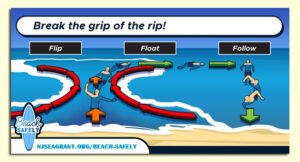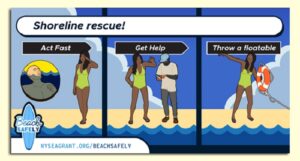Educators: check out these useful resources (lesson plans, worksheets, printouts and other interactive learning tools) to bring Ocean Fun Days straight to your classroom.
“BEach SAFEly” Campaign: During the pandemic, New Jersey Sea Grant Consortium and New York Sea Grant debuted a new social media graphic each week to remind beachgoers to stay safe while still having fun at the Jersey Shore and beyond!
Crab Anatomy Paper Craft: Grab some crayons, scissors and tape to make a Blue Crab … and locate the crab’s anatomy: their stomachs, heart and tiny brains! Please have adult supervision when using scissors.
Estuary Education: Estuaries are invaluable resources for coastal dwellers. These ecosystems offer protection, recreation and a wealth of learning opportunities. You’ll find a variety of resources to help share the wonders of estuaries with students and others.
“Hiker” Scouts Program: Why just walk when you can hike and learn about the environment around you? This short video will introduce New Jersey Sea Grant Consortium’s new virtual Scouts Program, “Hiker.”
Horseshoe Crabs 101: Want to learn more about horseshoe crabs? Check out this list of resources and workshops from several Ocean Fun Days exhibitors that includes images, poems and horseshoe crab chronicles from around the world!
How Do We Use Observer Data? NOAA’s Northeast Fisheries Science Center manages multiple observer programs covering federal and state waters from Maine to North Carolina. The team processes and manages data and biological samples collected by observers during commercial fishing trips.
Learning Through the Garden: Learn about school gardens and academic achievement with Rutgers’ New Jersey Agricultural Experiment Station.
Monmouth County GeoHub: Download open data and create your very own web maps to view a variety of data layers such as wetlands, tax parcel information and evacuation zones. Users can also view interactive maps and link to external data including sources from regional, state and federal agencies.
New Jersey Sea Grant Consortium Resources for Educators: Lesson plans, worksheets and additional initiatives appropriate for remote learning. Engaging virtual programs includes “Sharks vs. Rip Currents,” “Magnifying Plastics,” “Terrific Terrapins” and more!
NOAA Live! Webinars: This series from the 2020-2021 school year features a different NOAA expert/topic and a moderated Q&A session to give you a peek at what NOAA scientists do in all the various NOAA offices across the country. These webinars are geared toward grades two to eight and allow students to connect with scientists.
Northeast Fisheries Sampling Branch: Observers provide unique and independent information collected at sea, which is critical to the effective management of marine resources. The data are used to support sustainable fisheries and recover protected species. This brochure provides more information about this process.
Ocean Today/Every Full Moon: Explore NOAA’s supplemental resource for educators and learn more about the future of ocean farming.
Howard Lab at Sandy Hook Coloring Book and Activities: This 15-page marine life activity book has an eel maze, word search, crossword puzzle, facts about crabs and so much more!
The Story of Sandy Hook: Watch this 30-minute clip on “Restoring the Past” featuring interviews with members of the Army Ground Forces Association (sponsored by Raritan Bayshore Country).
The World of Atlantic Right Whales (Grade 6-8): Lesson Plan and Activities: This detailed lesson plan for teachers guides you through the fascinating world of the North American right whale (Eubalaena glacialis) through activities and lessons on the ecology, biology and conservation of this endangered species. There’s a word search, puzzles, a mystery game and more.
Virtual Earth Day: Check out these virtual lessons created by the Americorps New Jersey Watershed Ambassadors Program.
Activities and more “fun stuff” can be viewed HERE!









